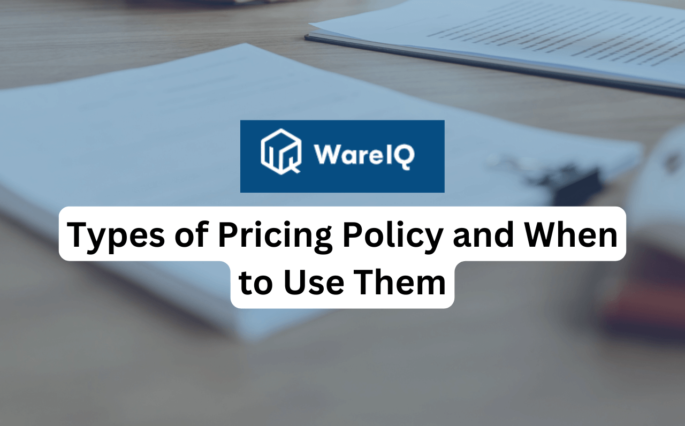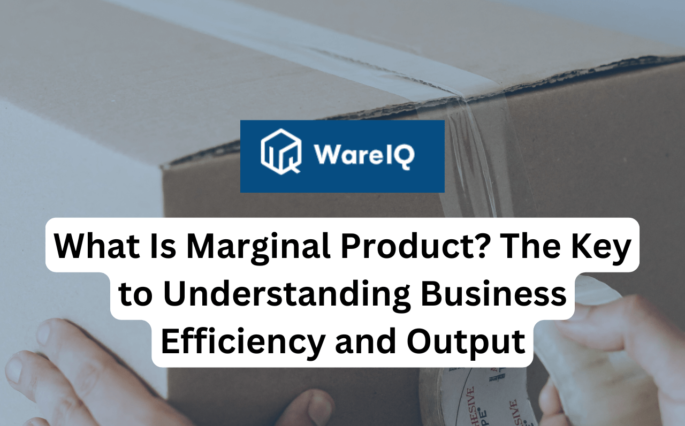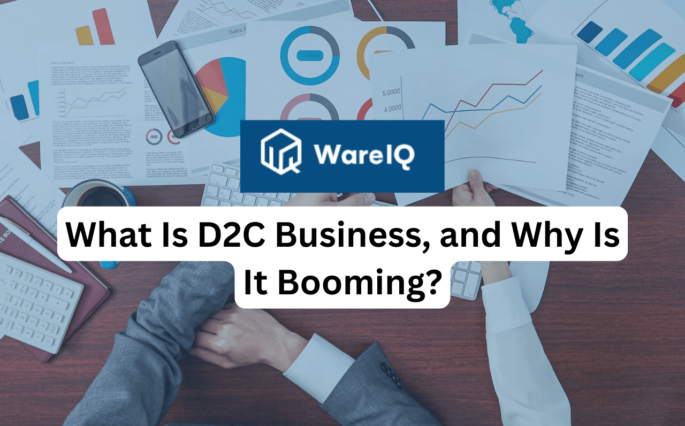What is Demand Forecasting? Definition, Types, Benefits of Forecasting Customer Demands for Ecommerce in 2025

Running an eCommerce logistics business is filled with challenges. These challenges are aggravated when businesses operate in a cutthroat environment where new competitions emerge daily. Organizations, therefore, try to forecast the upcoming market conditions, trends and requirement patterns to achieve sustainable growth.
As a business owner, you might have pondered on some or all of the questions below:
- What are the products you should produce to mitigate market demand?
- How many products do you need to store in distribution centres?
- What should be the exact closing inventory level to run the business successfully?
- What strategies do you need to adapt to deliver products in the shortest time?
The best way to get the answers to these questions is to understand demand forecasting.
This is the technique to understand future requirements and utilize them to improve your customer deliveries without compromising profit margins. Demand forecasting uses different factors to analyze customer behaviours, current and future trends, product acceptance, etc., to provide the best possible visibility for the future.
This article will walk you through the in-depth definition of demand planning & forecasting, the different types of demand forecasting and the reasons you should use it.
- What is Demand Forecasting?
- 6 Types of Demand Forecasting
- What are the Benefits of Sales/Demand Forecasting for eCommerce?
- Examples of Demand Forecasting
- How Does Demand Forecasting Affect Your Supply Chain and Fulfillment?
- Latest Trends of Demand Planning & Forecasting in 2025
- Conclusion
- How WareIQ Helps in Forecasting Demand For Its Partners
- Demand Forecasting & Planning FAQs
What is Demand Forecasting?
Demand forecasting is the process of making close-to-perfect predictions of the future requirements of all customers. This could be related to existing products you have been selling for years or any new item you plan to launch.
Businesses usually deal with stock-keeping units (SKUs), which may vary from hundreds to lakhs, depending on the type of business. The number of customers can also vary at a similar level.
Combining all the SKUs and customer demand for any short or long-term period creates a massive combination. Moreover, many more variables like the geographic location, specific time period and even specific projects make it more complicated. Demand forecasting combines all these variables and projects the best possible understanding of the demand pattern in the supply chain.
Demand forecasting, also known as sales forecasting, has different factors such as quarterly forecasts, monthly demand planning, weekly sales forecasts and even daily demand plans. In the case of highly perishable goods like food items, you can even see hourly supply and demand planning.
The more accurate your demand planning & analysis is, the more it helps to boost your supply chain efficiency. This is because your overall supply-chain planning depends on the accuracy of your demand analysis.
Based on the demand pattern, the supply team plans the inventory strategy and estimates the in-house capacity, materials, ordering pattern, stocking policy, etc. These are the critical factors of an efficient supply chain.
WareIQ, an eCommerce fulfillment company, empowers online brands with a superior-tech platform to compete with Amazon like service levels by bringing their average delivery timelines from 5-10 days to 1-2 days.
6 Types of Demand Forecasting
Based on different business models, experts have created different demand forecasting techniques:
Passive Demand Forecasting
The passive demand forecast model is one of the simplest forms of demand analysis in the supply chain. Here, the historical data is analyzed and used to predict the future requirements of customers.
In the case of seasonal demand, this forecasting method is useful. For instance, an umbrella manufacturing company can assume whether the same quantity of products will be required in the next year as the previous year.
In this scenario, some thumb rules are used along with the past sales data. For example, simply assuming a 10% increase from last year’s sales will be the forecast for the following year.
It is that simple. But in this planning methodology, you need to have in-depth historical data for a more extended period to reach a higher level of forecast accuracy.
Active Demand Forecasting
The active model is more scientific and data-driven. It not only relies on historical data but also considers external factors to conduct demand forecasting.
For example, deep market research, marketing campaigns, economic growth, government notifications, budget plans and local and global political conditions all are considered during the demand analysis.
In most cases, startups and organizations entering a new market perform this type of demand analysis. However, there is very little historical data available in these cases and demand planners rely on market surveys and research to generate sales forecasting in the supply chain.
Therefore, this type of demand planning needs more analysis to avoid any assumptions. Nowadays, organizations use advanced software to perform qualitative and quantitative analyses to get accurate information about every product.
Short-Term Demand Forecasting
Demand forecasting is also done based on the time horizon. Short-term demand analysis usually considers a time frame of the next three to twelve months. This enables a more accurate percentage.
Usually, the demand analysis is made based on short-term predictions of future demand. This benefits the organization by reducing the required inventory, improving turn-around time, lessening lead time and enhancing flexibility in response to any fluctuations.
Even during the in-house capacity planning, considering the short-term requirement forecast is the smartest method. It helps avoid unnecessary change over time and provides better visibility on your short-term decision making.
Long-Term Demand Forecasting
Long-term demand forecasting is more like a strategic plan for business growth and development. Usually, organizations consider a five-year horizon for this type of planning.
When the marketing team considers penetrating new geographical areas to expand the business, they need to try to capture new customers, frame plans to launch new products, etc., the long-term demand analysis captures all the reports and data to populate the forecast.
Using this technique, you can plan your future roadmap and budget for different verticals. For example, based on the five-year plan, you can consider a significant capital investment, increase your marketing budget, create a robust plan to enhance your supply chain performance, etc. This long-term demand forecasting allows you to prepare your business for the future.
External Macro Level Forecasting
In this type of forecasting, the broader economic aspects are considered. For example, future economic trends may affect your business growth or give you a new opportunity.
Your organization may think of leveraging low commodity prices and rethink developing with a new supplier. In any case, you need a forecast on which you can rely and make decisions. This is the importance of external macro-level forecasting.
Internal Business Level Forecasting
Your internal demand forecast is used to identify the operation’s bottleneck and for you to take necessary action to remove it. Do you have enough in-house capacity to mitigate the high demand? Or do you need to enhance your production capacity?
Do you have a robust upstream (supplier side) that can meet timely requirements? You will get the answers to all these questions once you perform the internal business level forecasting.
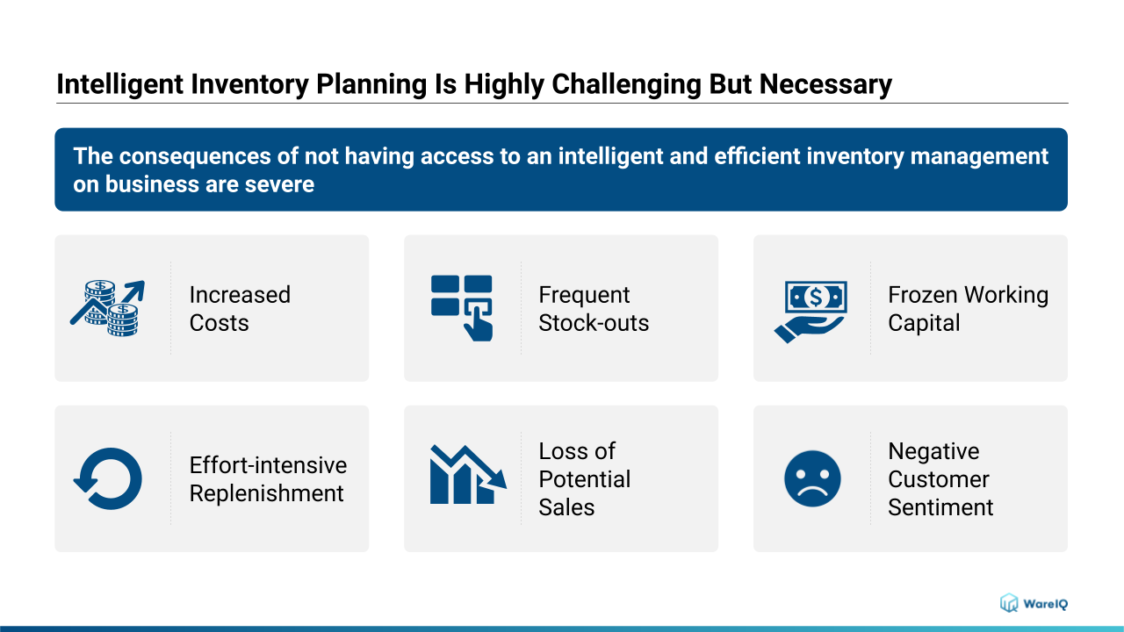
Suggested Read: How to handle stock-outs?
Suggested Read: What is Inventory replenishment?
What are the Benefits of Sales/Demand Forecasting for eCommerce?
Sales forecasting has much broader advantages than just managing optimum inventory or how much to order. Though the advantages are diverse, we have mentioned the most significant ones below:
Reduces Financial Risks
If robust data backs up financial decision-making, there is little chance of slippage. Demand forecasting provides evidence to craft an accurate budget. When you get a better idea of the demand of your customer base, it helps you improve your financial budgeting decisions.
For instance, when demand analysis tells you that the demand curve of any specific product is in a declining trend, you can decide to reduce the inventory levels of that SKU and its components.
This helps to reduce the risk of high amounts of obsolete and ending inventory. Similarly, if the forecast of a new product shows that its sales figures will take some time to shoot up, you can better manage your resource allocation.
Improves On-Time Delivery
Modern customers are highly demanding. They know their choices, and there are a wide array of options available. Oftentimes, buyers want the product right away. And if you fail to deliver, there are dozens of competitors who will do the same.
With the increase in customers’ expectations, businesses face a massive challenge in delivering products on time. Sales forecasting offers you the opportunity to reduce the lead time.
If you know the market demand of the specific product well ahead of time, you get the time to prepare your supply chain and thus, increase the shipping speed.
Increasing inventory levels, allocating in-house production capacity and keeping your distribution centres (DCs) ready with products, are key strategic actions to improve on-time delivery. This is not possible without smart demand planning & demand analysis.
Reduces Inventory Expenses
Inventory is the function of variation and is often called a necessary evil. An optimum inventory level helps the business capture competitive advantages by offering quick deliveries.
On the other hand, excess and obsolete inventory can drastically consume your profit. Accurate demand forecasting supports your inventory reduction approach. Your warehouse only has the required materials, which means less money is blocked.
Moreover, do not forget the inventory carrying cost. It comprises almost 25-30% of your total inventory. In-depth demand analysis helps the warehouse and fulfillment centers run efficiently by optimizing the space, resources, and utility charges.
Helps to Create a Pricing Strategy
Demand planning greatly supports you in strategically framing the pricing of your products. For instance, customers are ready to pay a reasonable price for products that are in high demand. Then, following the trends, you can tweak the pricing strategy of in-demand products.
Enables Better Negotiation
A demand pattern allows you to save a lot of money by helping in negotiation with suppliers and service providers. For example, you can manage to get a good discount on bulk purchases if you know that the demand will rise.
Moreover, for commodities that have fluctuating price trends and high forecasts, you can negotiate with the vendor to keep safety stock with them. This will help you get a better price and avoid inventory carrying costs.
Examples of Demand Forecasting
Projecting Trends
Imagine that there is a business operated by 2 partners that sell toys, clothes and other items for kids and they have been operating for around 10 years. They have reached their goals in terms of revenue and profitability and are comfortable with operating at this pace instead of expanding.
To project trends for next year, they take the average of the last 3 years of historical sales data. This data shows them that they are the most successful in July and October and that they perform at their lowest levels in January and February. They can utilize these analytics to project future trends so that they can accurately place orders, hire temporary staff in seasons of high demand and create plans for promotions during slower months to generate more hype.
Conducting Market Research
Suppose that a new company has researched and developed advanced wireless headphones and the brand was launched through the crowdfunding platform Kickstarter. While they were able to get decent exposure, they have the objective of expanding their target audience in order to meet their targets.
They encourage customers to take part in a survey and using the responses and details such as age, income, location, etc. they identify the current customer base of the company and realise that their product is most popular amongst people who commute via public transport.
Based on this information, they create a marketing plan that focuses on ad campaigns targeting at people who ride on buses and trains. They highlight how their product would be helpful in these situations and are able to forecast the upcoming future demand.
Using Sales Force Composite
Imagine that a brand sells high-quality office chairs targeted at both B2B and B2C customers. In the past, they have primarily had high demand from the B2B sector and have received huge orders from other organizations but for the past quarter, business has been slow.
The members of the sales team share the feedback that they have received from customers which helps them identify a market trend. Because more people are working from home and businesses no longer require large office spaces, they have no requirement for office furnishings.
The company then forecasted demand for the next quarter with reduced sales and also decreased its production capacity. This gave them time to restructure its marketing strategies to meet the change in demand.
How Does Demand Forecasting Affect Your Supply Chain and Fulfillment?
In this modern era, eCommerce fulfillment businesses can only sustain themselves if they have an agile and resilient supply chain. If they don’t have visibility on customer requirements, all the business processes will run on assumptions.
You may have products that are not required, a pile of stationery inventory that will become obsolete soon, a production line with frequent changes and much more. All these activities trigger inefficiency in fulfillment centers.
Poor demand forecasting will affect the internal business operations and your upstream (vendors and service providers) will also face colossal disruption. Due to the bullwhip effect, suppliers will face high volatility in ordering patterns, inventory planning, stocking policy and other SLA items in the supply chain. These unwanted disruptions will hamper your long-term business relationship. There will be overstocking at every stage, even at the supplier’s end.
The most impacted area will be your downstream (the customers’ side). The disruption in the supply chain will increase the lead time. As a result, customers will need to wait longer for deliveries which will make them move to competitors and never recommend your products to others. This is definitely not good for your brand reputation.
Suggested Read: Why is Supply Chain Agility Crucial to eCommerce in 2025?
Latest Trends of Demand Planning & Forecasting in 2025
Seasonality of Demand
Seasonality is a factor where the demand and supply increase or decrease due to a particular event or time of the year. For instance, during holidays like Christmas or New Year, the sale of household products and gift items increases. Similarly, you can observe increased sales of umbrellas or raincoats during the rainy season.
Dependency on Global Phenomenons
The global economy is more interconnected than ever before. This has been made more apparent by the onset of the global pandemic and the ongoing war in Ukraine, which have had a severe impact on manufacturing, transportation of products and materials and the supply chain as a whole.
You may think that events that happen in distant countries have no effect on you receiving your orders on time, if at all, but alas, they definitely do because most manufacturers import at least some of their materials from countries like China. This is why demand planning is important because it can preemptively determine whether these global events will have any impact on your business or not and can easily ascertain what those impacts could be.
Requirements to Increase Sustainability
Companies the world over are succumbing to growing awareness about the environmental impact that certain manufacturing and supply chain processes have on the planet. Companies are under increased pressure to use sustainable materials in their packaging and to reduce their carbon footprint as much as possible. However, these factors can have a drastic increase in logistics costs so companies need to find the right balance between being environmentally friendly and maintaining their bottom line and this is where demand forecasting can help them get to that balance.
Multi-Functioning of Demand Forecasting
In the past, demand forecasting, while still an important business process, was usually contained within certain departments. However, this is becoming the exception because most companies now understand the value of sales forecasting and how it can have a positive effect on the entire business. Teams are now striving to find ways to integrate the process of demand analysis with every sector of the business to achieve the best results.
Diminishing Importance of Spreadsheets
While spreadsheets will always have their importance for maintaining data and an easy-to-understand way, many companies are adopting more advanced methods to demand planning by relying on automation, software solutions and AI to be able to predict varying demand levels for different products in various markets for a specified time period in the future. This helps in mitigating any manual errors or confusion that could occur due to maintaining hundreds of different spreadsheets
Conclusion
Businesses need to understand their customers and the best way is to use demand forecasting. It helps make smart decisions based on future visibility. Many organizations have realized its benefits and have already implemented this process.
Demand analysis cannot always be 100% accurate but a proper demand analysis and market research can come close. It considers historical data, sales data, market research and economic factors to perform permutation combinations to keep your business strong, agile and prepared for the future.
WareIQ is an eCommerce fulfillment company that effectively predicts demand beforehand for its eCommerce partners using its superior WMS (Warehouse Management Software) platform & enables efficient inventory planning & placement.
How WareIQ Helps in Forecasting Demand For Its Partners
Supply Chain Management Systems (SCMS) is used by WareIQ to forecast supply chains. Our supply chain managers are also educated to predict demand using various approaches. A variety of things can have an impact on a firm and no two sectors are alike.
While some of these demand forecasting methods do not require SCMS, the majority of them work well with it to provide an effective supply chain from top to bottom.
You can also Read : Inventory Forecasting in Supply Chain
Buyer Trend Analysis
Everything goes out of style and it frequently happens without warning. Buyer trends are tough to follow but doing so may be quite profitable. To fulfill consumers’ fluctuating wants, your supply chain must be adaptable enough to add large quantities of an item in a short period of time.
At the same time, being aware of buyer trends may save you from having static inventory and keep your supply chain’s operating expenses low. Fortunately, logistics allows for achieving the required amount of inventory.
Demand Forecasting Management
Demand forecasting wouldn’t be necessary if trends were similar year after year. All demand fluctuations, like any other metric, include exceptions. When a projected shift in demand does not occur, having an effective demand exception management strategy could help you manage inventory more effectively.
WareIQ identifies and tracks any deviations in projected demand in this sales forecasting model. If it seems that an exception may arise, the supply chain will be prepared to respond immediately, avoiding hidden costs or missed opportunities.
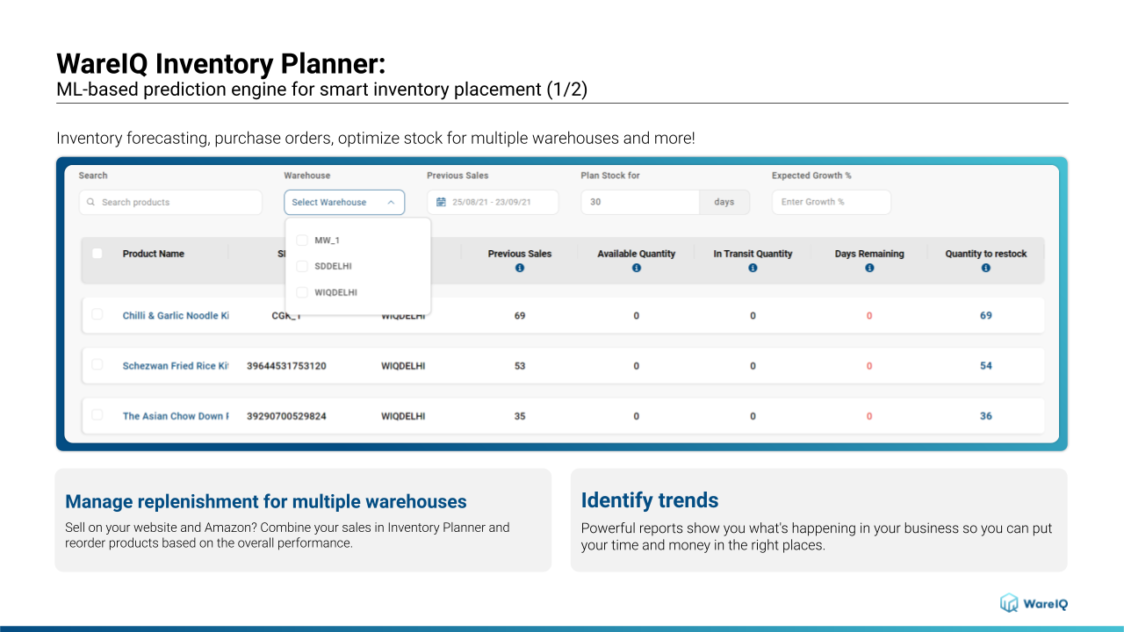
Intuitive Planning
When you suspect that anything is threatening your supply chain, the best solution is to rely on your D2C fulfillment partner’s statistics and instincts. Trust WareIQ as your retail fulfillment partner since we forecast based on our own experiences. By sensing prospective fluctuations in customer demand, our seasoned supply chain specialists can identify them. This is known as intuitive planning.
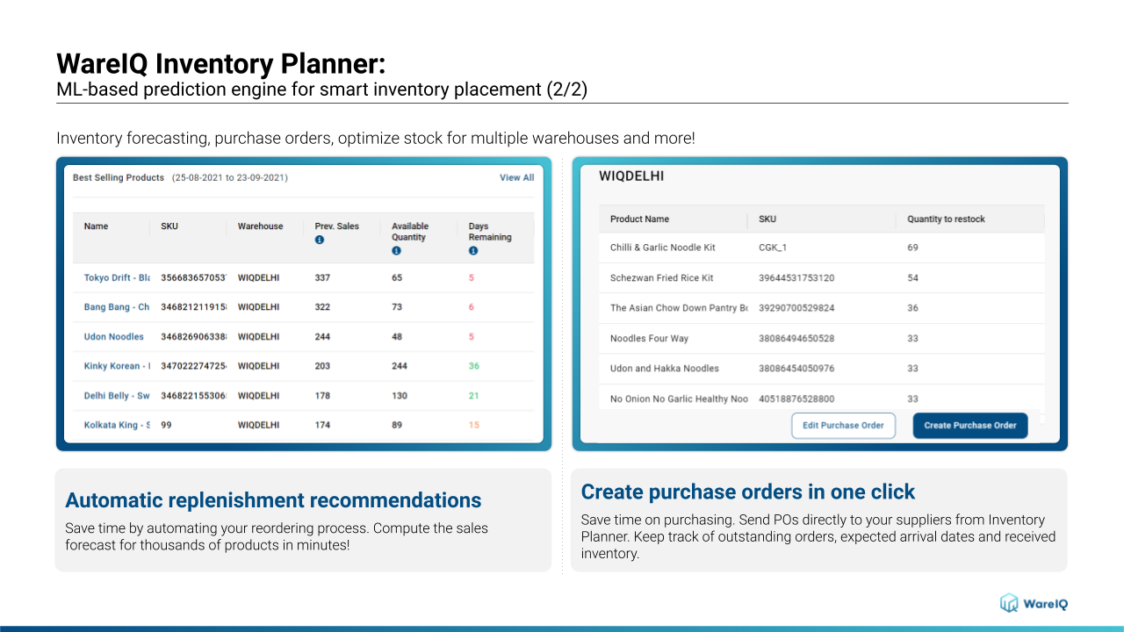
Intuitive planning considers everything you cannot comprehend manually. For example, an eCommerce business may intend to acquire a competitor in the future. Of course, you were unaware of this news at the beginning. However, our popular wisdom suggests that this will result in more consumers, implying increased buyer demand.
Intuitive planning is not as sophisticated as the other demand forecasting approaches, yet it is still effective.
- Pan India Fulfillment & Darkstore Network: Plug-and-play fulfillment infrastructure with no minimums, which is compliant with Amazon Seller Flex, Flipkart Assured, Myntra and other marketplaces
- Inventory & Network Planning Excellence: Best-in-class AI models for sales forecasting, product segmentation, and inventory management to reduce inventory by 40% and increase revenue by 10%.
- Vertically Integrated Fulfillment Tech Stack: Our Fulfillment Tech Solution supports integrations with 20+ top marketplaces & D2C platforms, and prominent national, regional and hyperlocal couriers, enhancing reach by covering deliveries for 27,000+ pin codes
- Supply Chain Productivity Applications: Integrate a host of supply chain productivity apps with a single-click to your existing CRMs, ERPs & accounting software to manage your logistics workflows from one command center. Use Apps like RTO Shield to get 100% RTO protection, Branded Tracking to turn your order tracking page into a profitable marketing channel, and many more.
Trusted by 300+ top Indian brands, we are helping them accelerate online sales and expedite their growth through a synergistic combination of advanced technology, robust fulfillment infrastructure & seller enablement services!WareIQ is backed by leading global investors including Y Combinator, Funders Club, Flexport, Pioneer Fund, Soma Capital, and Emles Venture Partner.





